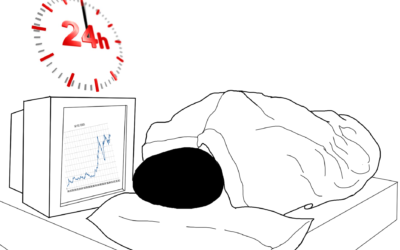Relative strength index (RSI) is a technical momentum indicator most traders use in the market. It was developed by J. Welles Wilder.
The Relative Strength Index consists of a single line, which fluctuates between 0-100.
Relative strength index (RSI) helps traders to measure the strength of the upward movements and downward movements.
Traders also use it to identifies the overbought and over sold conditions on the market chart. It also compares the higher and lower closing prices.
Let’s look at the illustration below;

RSI scale ranges from 0 to 100% and shows overbought and over sold conditions.
When the RSI reads 70% and above, it shows that the market is overbought hence a possible change in trend direction. Or else, it indicates oversold conditions when the RSI is below 30% (bullish reversal).
In addition, if the RSI reads greater than 50, it indicates that the upward force is greater than the downward force so it is a strong uptrend.
Whereas, when it goes below 50, the downward force is stronger than the upward force therefore a strong downtrend.
From the Image above;
- 0-30: Oversold Market Conditions
- 30-70: Strong trend
- 70-100: Overbought Market Conditions.
RSI formula
RSI = (100—(100/(1+RS)))
Where RS is the relative strength
RSI = (14 EMA on last 14 up bars/14 EMA on the last 14 bars down)
It is set at 14 EMA (Exponential Moving average) default.
How to trade using Relative Strength Index (RSI)
You can trade RSI in 2 different ways. That is;
- When the market shows Overbought or Oversold conditions.
- Trading divergences on RSI indicator.
Oversold Market Conditions
When the RSI indicator reads 30% and below, it means that the market is oversold, and that the price might eventually increase. As a result, there is a likelyhood of change in trend direction.
Once you confirm the trend reversal, take a buy position.
Overbought market conditions
Likewise, when you notice that the RSI reads 70% and above, market shows overbought conditions hence a good signal for a bearish reversal.
Wait for confirmation and take a sell position.
It is very important to get more confirmation for the signals for example combining RSI with other indicators and candlestick patterns. Let’s look at an example below;
RSI Overbought and Oversold conditions on a forex chart below.

The chart above shows how a RSI Overbought and oversold signal may appear.
The RSI line breaks through to the 0 – 30 area first. This gives the oversold signal. The price then moves out of the oversold zone confirming the buy signal as shown on the chart above.
As you can see, we took our first buy position. Price then stayed between 30 – 70 area for a while as indicated on RSI indicator. This indicates a strong uptrend. You can confirm from the chart.
When the indicator broke the 70 level. It shows that the market is overbought. Try to compare the RSI indicator with price momentum. Do you see a change in price movement?. price seem to congest/slow down as the RSI crosses the 70 level.
As the price moves out of the overbought zone, it creates the sell signal on the chart. This gives you a strong confirmation to sell.
Note that we didn’t take the entries at A and B because the RSI didn’t go into the the overbought/ oversold condition zones.
Trading divergences using relative strength index (RSI) indicator
The RSI can also be traded by looking for bullish and bearish divergences between the RSI and the currency price movement.
If the price reaches higher highs but RSI is not able to to reach the new higher high, there is a bearish divergence. Sell on completion of the divergence.
If price reaches the new low and RSI fails or forms a high, there is a bullish divergence. Buy after noticing this kind of divergence.
Divergences are more significant after an overbought or oversold scenarios.
Let’s have a look at the GBPUSD, 4-Hour chart below.

From the chart above, note that the price at A and RSI all had clear lows, when price hit a new low at B, the RSI formed a high. This is a bullish divergence and indicates an uptrend trend hence a buy signal.
For a bullish divergence strategy, set your stop loss slightly below the lower low. similarly, set stop loss for a bearish divergence at slightly above the higher high.
Combining RSI with support and resistance is used with RSI
This commonly applies very well while trading ranging markets. As prices bounces off support and resistance levels in a range, watch RSI for overbought and oversold conditions.
Let’s take a look at the USDJPY Daily below;

Note that as price bounced off support the RSI showed oversold conditions, this is a buy signal. As price bounced off resistance, the RSI was showed overbought conditions, this is a strong sell signal.
How long should you hold an Open Position ?
How long you can hold an open position in forex, is a personal thing for all traders. The decision is all yours. You know what your goals are as a trader, the kind of strategy you use to trade. All this starts from what you are? and What you want? If I am to answer,...
- Oh, bother! No topics were found here.



